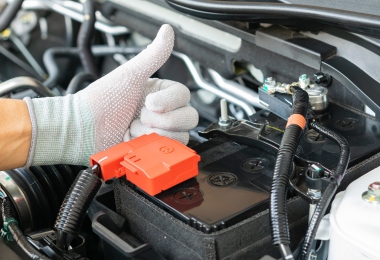As an Amazon Associate, I earn from qualifying purchases at no extra cost to you.
Battery Light On But Car Runs Fine: Unraveling the Mystery
If the battery light is on but the car runs fine, it could indicate a potential issue with the charging system. It’s essential to have the vehicle inspected by a qualified mechanic to diagnose and address any underlying problems.
Ignoring the warning light may lead to a drained battery and ultimately, the car stalling. The battery light coming on may suggest a problem with the alternator, drive belt, or battery itself. Regular maintenance and timely repairs are crucial to ensure the car’s reliable performance.
In the following parts of this article, we will explore potential causes of the battery light being on, their implications, and what steps to take to resolve this issue. It’s important to address this warning sign promptly to avoid being stranded due to a potential electrical system failure.
Common Causes Of Battery Light On
Loose Or Damaged Battery Cables
If your battery light is on, one common culprit could be loose or damaged battery cables. Loose connections or frayed cables can disrupt the flow of electricity between the battery and the rest of the car, triggering the battery light. It’s essential to regularly inspect battery cables for any signs of wear or looseness and promptly address any issues to avoid potential problems down the road.
Faulty Alternator
Another prevalent reason the battery light may illuminate is a faulty alternator. The alternator’s primary function is to provide power to the car and charge the battery while the engine is running. If the alternator is defective or failing, it can result in inadequate charging, which may trigger the battery light. Keep an eye on dimming lights, unusual noises, or difficulty starting the car, as these could be indicators of an alternator issue.

Credit: www.johnsautocareandtire.com
The Role Of Alternator
Battery light on but car runs fine? Understanding the role of the alternator can help you diagnose the issue. The alternator plays a crucial role in producing electricity to charge the battery and power the electrical system in your vehicle.
Charging The Battery
The alternator charges the battery while the vehicle is running. It converts mechanical energy from the engine into electrical energy, which is then used to recharge the battery. This continual charging process ensures that the battery has enough power to start the car and operate the electrical components.
Powering The Electrical System
In addition to charging the battery, the alternator is responsible for powering the electrical system of the car. It provides electricity to the various components such as lights, radio, and air conditioning. Without the alternator, the electrical system would not function properly, leading to issues with various functions of the car.
Signs Of A Failing Alternator
The battery light on but the car running fine could signal a failing alternator. Dimming headlights and difficulty starting are other common signs to watch for. It’s essential to address these issues promptly to prevent further damage and ensure safe driving.
Dimming Headlights
Dimming headlights while driving could be a sign of a failing alternator. It means it’s not charging the battery properly.
Strange Noises
Strange noises like whining or grinding could indicate alternator issues. These sounds can signal potential mechanical failures.

Credit: www.ebay.com
Effects Of Ignoring The Issue
Ignoring the battery light on while your car runs smoothly can have serious consequences. Failure to address this issue could result in a dead battery, electrical problems, or even a breakdown at an inconvenient moment.
Battery Draining Faster
Ignoring the issue of a battery light on while the car runs fine can have several negative effects. One of the most common effects is that the battery may start draining faster than usual. This happens because the alternator, which is responsible for charging the battery, may not be functioning properly. As a result, the battery is not getting enough power to recharge itself fully, leading to a faster drain. This can be especially problematic if you rely on your car for daily commuting or long drives.If you ignore this issue, you may find yourself with a dead battery at the most inconvenient times and places. So, it is essential to address the battery light as soon as it appears.Risk Of Stalling
Another significant risk of ignoring the battery light on but the engine running fine is the increased chance of stalling. The battery light indicates that there is a problem with the electrical system, which includes the charging system. If the alternator is not functioning correctly due to a faulty connection or a worn-out component, it may fail while you are driving. When this happens, the battery will no longer be able to provide power to the spark plugs, and the engine could suddenly stall, leaving you stranded on the road.This not only poses a safety risk but can also lead to costly repairs, such as replacing the alternator or other electrical components. Additionally, frequent stalling can put unnecessary wear and tear on other parts of your car, such as the starter motor and fuel pump, resulting in even more expensive repairs in the long run.Ignoring the battery light on your car dashboard may seem like a tempting option when the car runs fine. However, the effects of ignoring this issue can worsen over time and end up costing you more in repairs. So, if you notice the battery light on, prioritize getting it checked by a qualified mechanic to prevent further problems and ensure the longevity of your vehicle.Diagnostic Steps
If your battery light is on but your car is running fine, it can be quite puzzling. Don’t panic, though. There are a few diagnostic steps you can take to determine the cause of the issue and prevent any unexpected breakdowns. By following these steps, you’ll be able to identify whether it’s a problem with the battery connections or the alternator voltage.
Check Battery Connections
Start by examining the battery connections, as loose or dirty terminals can trigger the battery light. Here’s what you can do:
- Turn off your car’s engine and engage the parking brake for safety.
- Open the hood of your car and locate the battery.
- Inspect the battery terminals for any signs of corrosion, such as white or greenish deposits.
- If you notice corrosion, disconnect the battery cables using a wrench.
- Clean the terminals and cable ends with a wire brush, ensuring a proper connection.
- Reconnect the battery cables tightly.
After completing these steps, start your car and check if the battery light is still illuminated. If it remains on, move on to the next diagnostic step.
Test Alternator Voltage
If the battery connections are in good condition, the next step is to test the alternator voltage. Follow these instructions:
- Make sure the engine is running and the battery light is still on.
- Using a voltmeter, connect the positive (red) lead to the positive terminal of the battery and the negative (black) lead to the negative terminal.
- Note the voltage reading on the voltmeter while the engine is running.
- A functioning alternator should show a voltage reading between 13.8 and 14.7 volts.
- If the reading is below this range, it indicates a potential issue with the alternator.
If the voltage reading falls within the correct range, the problem might be with the battery itself. On the other hand, if the voltage reading is below the specified range, it’s a good idea to have your alternator checked by a professional mechanic.
By following these diagnostic steps, you can identify whether the battery connections or alternator voltage are causing the battery light to stay on. Remember, if you’re unsure about conducting these tests yourself, it’s always best to consult a qualified mechanic to ensure an accurate diagnosis and proper resolution of the issue.
Possible Solutions
Possible Solutions:
Tighten/replace Battery Cables
Inspect battery cables for corrosion or looseness. Tighten or replace cables if needed.
Repair Or Replace Alternator
If battery light stays on, check the alternator. Consider repairing or replacing it.
Preventive Maintenance Tips
Preventive maintenance is key to ensuring the longevity and optimal performance of your vehicle. By performing regular inspections and following these essential tips, you can help prevent issues related to the battery, ensuring a trouble-free driving experience.
Regular Inspection
Regular inspection of the battery is crucial for identifying any signs of wear or potential issues. Keep an eye out for corrosion on the battery terminals and any physical damage to the battery itself. Additionally, check the electrolyte levels if you have a non-sealed battery, and ensure they are at the recommended levels. If you notice any abnormalities, it’s best to have the battery checked by a professional.
Keeping Battery Terminals Clean
Clean battery terminals are essential for maintaining a strong connection and preventing electrical issues. Use a battery terminal brush to remove any corrosion or buildup from the terminals, and apply a thin layer of petroleum jelly to prevent future corrosion. This simple maintenance task can significantly extend the life of your battery.
Consulting A Professional
When it comes to dealing with a battery light on but a car that runs fine, it’s essential to consider seeking expert advice. While a car may seem to be running fine despite the warning light, it’s crucial to understand that there could still be underlying issues that need to be addressed by a professional. Consulting a qualified mechanic or automotive technician can provide the necessary insight and solutions to ensure the overall safety and performance of your vehicle.
Seeking Expert Advice
Seeking expert advice is crucial when dealing with a battery light issue in your car. It’s always recommended to consult with a professional to accurately diagnose and address the potential underlying problems. By reaching out to a qualified mechanic, you can gain valuable insights and ensure that necessary steps are taken to maintain the functionality of your vehicle.
Professional Diagnostic Testing
When facing a battery light issue in your car, professional diagnostic testing is essential. A skilled technician can perform a comprehensive assessment using specialized tools to identify any electrical, charging system, or battery-related issues. Through professional diagnostic testing, they can pinpoint the root cause of the problem and provide effective solutions to rectify the issue.

Credit: blogs.library.duke.edu
Conclusion
If your battery light is on while the car runs fine, it’s wise to not ignore it. An early check can avoid potential issues. Ensure to get a professional inspection to diagnose and address any underlying problems. Stay proactive in maintaining your vehicle for smoother rides ahead.











